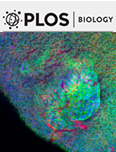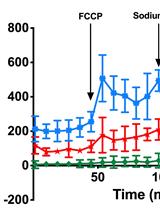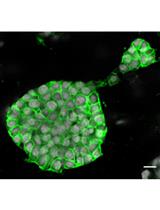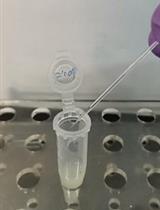- EN - English
- CN - 中文
Maintenance of Schmidtea mediterranea in the Laboratory
实验室真涡虫的保存
发布: 2018年10月05日第8卷第19期 DOI: 10.21769/BioProtoc.3040 浏览次数: 6514
评审: Ivan ZanoniAchille BroggiMarco Di Gioia
Abstract
In the last years, planarians have emerged as a unique model animal for studying regeneration and stem cells biology. Although their remarkable regenerative abilities are known for a long time, only recently the molecular tools to understand the biology of planarian stem cells and the fundamentals of their regenerative process have been established. This boost is due to the availability of a sequenced genome and the development of new technologies, such as interference RNA and next-generation sequencing, which facilitate studies of planarian regeneration at the molecular and genetic level. For these reasons, maintain a healthy and stable planarian population in the laboratory is essential to perform reproducible experiments. Here we detail the protocol used in our laboratory to maintain the planarian species Schmidtea mediterranea, the most widespread as a model.
Keywords: Planarian (真涡虫)Background
Planarians are bilaterally symmetric platyhelminthes, members of the superphylum lophotrochozoa. There are terrestrial, marine, and freshwater planarians. They prey predominantly upon injured insects, insect larvae, and other invertebrates. Planarians are triploblastic and acoelomated animals that lack circulatory, skeletal, and respiratory systems (Figure 1A). These animals have the amazing ability to restore any missing part of their body after an amputation in a few days (Reddien and Alvarado, 2004; Salo, 2006); and to grow and degrow depending of the environmental conditions and food availability (Baguñá and Romero, 1981). These characteristics are due to the presence of an adult stem cell population – called neoblasts – that is able to give rise to any planarian cell type (Reddien and Alvarado, 2004; Salo, 2006). The high regenerative capacity of planarians, with the presence of a unique totipotent stem cell system, provides an ideal model for studying cell renewal, regeneration, and stem cell regulation. Schmidtea mediterranea is the most common planarian species used in molecular biology to perform molecular and cellular studies, because it presents special features that optimize research. For instances, they are easily maintained as a stable clonal line in the laboratory due to their robust ability to regenerate, which allows a uniform genetic background and minimizes the experimental variability. Here we detail the protocol used in our laboratory to maintain the planarian species Schmidtea mediterranea.
Materials and Reagents
- Glass Tupperware (Figure 1B)
The size may vary depending on the requirements of each experiment. You must avoid large containers that can be too heavy and difficult to manipulate. - Assexual planarian clonal line of the asexual strain of Schmidtea mediterranea
This species can be found in coastal areas in the Western Mediterranean. The origin of the strain used in most labs are the fountains of Montjuic in Barcelona. The easiest source nowadays is asking directly from our laboratory or any that has already stablished it as a model organism. - Organic beef liver
Note: It can be purchased in any butcher shop that sells organic meat. - NaOH (Merck, catalog number: 106462 )
- MgSO4•7H2O (Merck, catalog number: 105886 )
- NaHCO3 (Merck, catalog number: 106329 )
- KCl (Merck, catalog number: 104936 )
- MgCl2•6H2O (Merck, catalog number: 105833 )
- CaCl2•2H2O (Merck, catalog number: 102382 )
- MilliQ water
- 100x Planarians Artificial Medium (PAM) stock solution (see Recipes)
- 100x CaCl2 Stock solution (see Recipes)
Equipment
- "Planarium"–room or incubator at 20 °C (Figure 1C)
- 1 L Beaker
- Magnetic stirrer
- Stir bar
- 1 L Graduated cylinder
- 1 L Crystal bottle
- Water tank
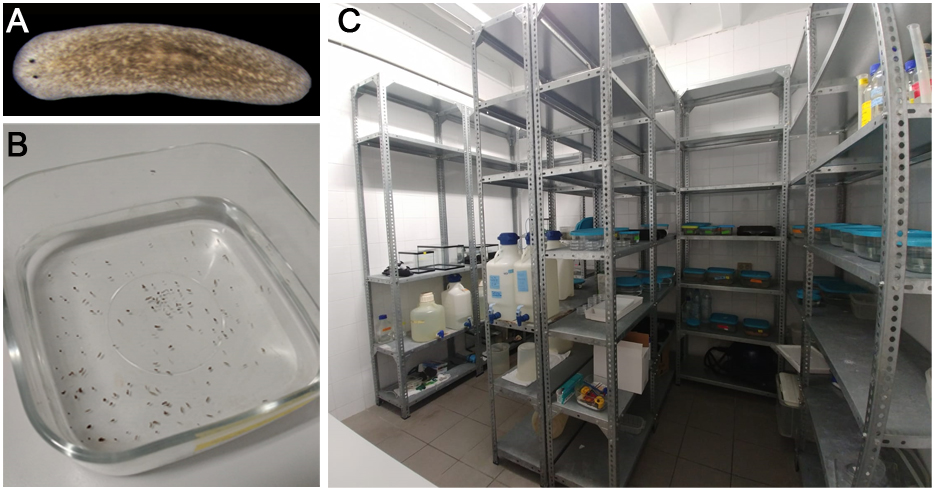
Figure 1. Culture of Schmidtea mediterranea. A. In vivo planarian from the species Schmidtea mediterranea. B. Glass Tupperware with planarians. C. “Planarium” (room at 20 °C).
Procedure
文章信息
版权信息
© 2018 The Authors; exclusive licensee Bio-protocol LLC.
如何引用
Sousa, N. D. and Adell, T. (2018). Maintenance of Schmidtea mediterranea in the Laboratory. Bio-protocol 8(19): e3040. DOI: 10.21769/BioProtoc.3040.
分类
细胞生物学 > 模式生物培养 > 保存
干细胞 > 成体干细胞 > 维持和分化
您对这篇实验方法有问题吗?
在此处发布您的问题,我们将邀请本文作者来回答。同时,我们会将您的问题发布到Bio-protocol Exchange,以便寻求社区成员的帮助。
提问指南
+ 问题描述
写下详细的问题描述,包括所有有助于他人回答您问题的信息(例如实验过程、条件和相关图像等)。
Share
Bluesky
X
Copy link


